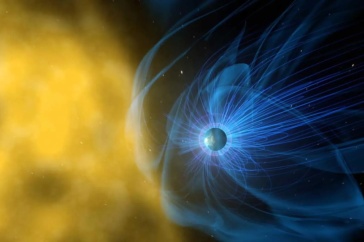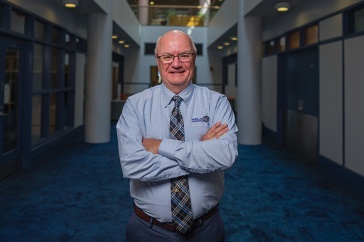
UNH research professor Charles Smith is being recognized for his outreach efforts, including his leadership of Project SMART's Space Science Module that involved a scientific balloon launch for high school students.
UNH research professor Charles Smith has been selected for the 2020 Space Physics and Aeronomy Richard Carrington (SPARC) Education and Public Outreach Award. The award, presented annually by the American Geophysical Union, recognizes a scientist who has helped to improve the public’s understanding of space physics and aeronomy through their outstanding educational and outreach efforts.
“I think outreach is important in all areas of science and engineering; frankly, I think it's important in all walks of life,” Smith says. “Young students are trying to find themselves and what they get in a classroom is highly structured. They need to see what it's really like. Students need to learn to test their efforts when there isn't an answer in the back of the book and they need to embrace surprises.”
"I find that working with young students recharges my batteries and reminds me that there is excitement in what we do."
“Being named a Carrington honoree is a remarkable honor and I am genuinely humbled by it,” he adds. “I collaborate with many top-flight researchers and some excellent students, so I feel this award is as much theirs as it is mine.”
The SPARC Award is named for Richard Carrington, an English amateur astronomer who demonstrated the existence of solar flares in 1859 and whose sunspot observations in 1863 revealed that the sun rotates faster at the equator than at the poles. Only one scientist receives the SPARC Award each year.
Smith began his career at UNH in 1981 as a research scientist. He left in 1987 to work for the University of Delaware, but then returned to UNH in 2003 and has since served as a research professor at the Space Science Center. Outside of his scientific research, Smith is an ardent advocate for hands-on, extracurricular science experiences for students of all ages. He spent years leading the UNH Project SMART space science module, where middle and high school students focus on learning real-world physics and related technologies for four weeks in the summer. Some of those Project SMART students subsequently conduct space physics research with him, even going on to publish their work in peer-reviewed scientific journals — all before they even graduate with their bachelor’s degree. Their engagement with space physics outside the typical school curriculum speaks to Smith’s ability to ignite a spark in their imaginations and foster their curiosity for the topic.
Smith is currently involved in Space Weather Underground, a program that encourages high school students in northern New England to build their own magnetometers and measure small changes in the Earth’s magnetic field. Currently 14 schools are involved with the program, but he hopes to reach even more in the coming years.
“I find that working with young students recharges my batteries and reminds me that there is excitement in what we do,” Smith says. “Seeing the work through their eyes makes me see what we do in a new light. It's not just interesting, but it's fun as well.”
The Institute for the Study of Earth, Oceans, and Space (EOS) is UNH's largest research enterprise comprising six centers with a focus on interdisciplinary, high-impact research on Earth and climate systems, space science, the marine environment, seafloor mapping, and environmental acoustics. With more than $58 million in external funding secured annually, EOS fosters an intellectual and scientific environment that advances visionary scholarship and leadership in world-class research and graduate education.
-
Written By:
Rebecca Irelan | Institute for the Study of Earth, Oceans, and Space | rebecca.irelan@unh.edu | 603-862-0990


















































